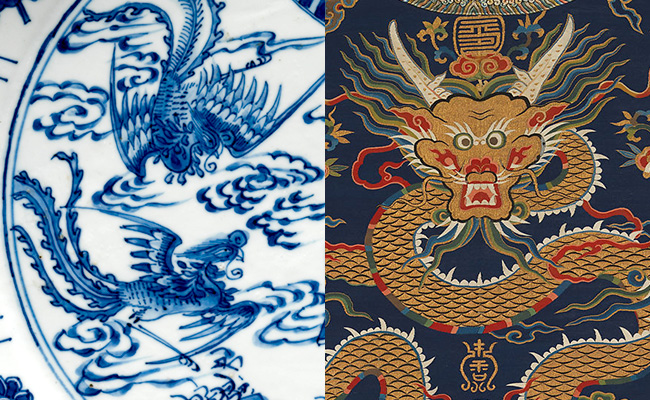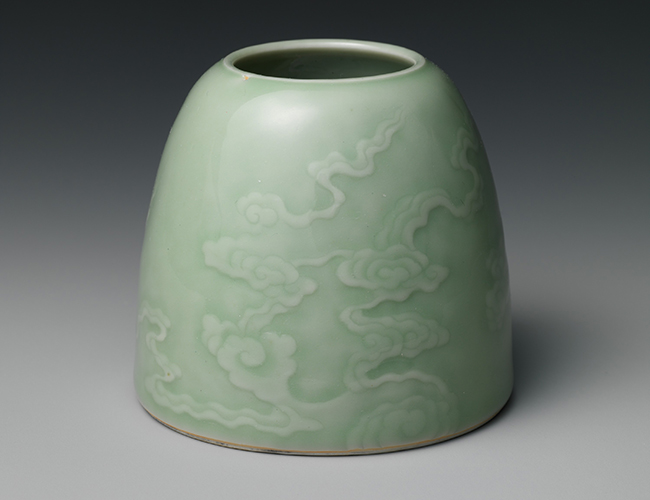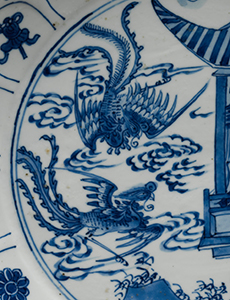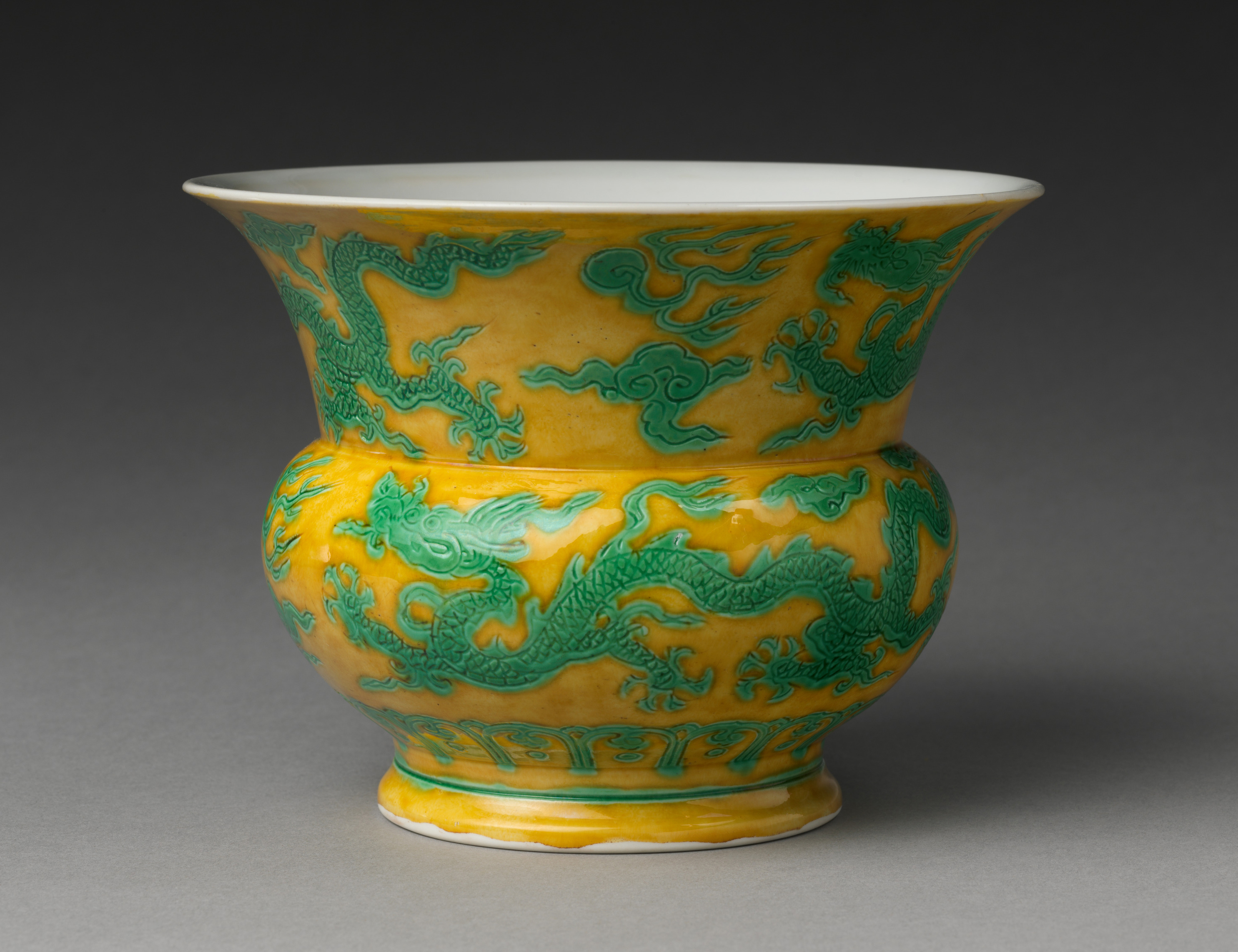
Decorações artísticas tradicionais chinesas: Os Céus e o Paraíso além
As lendas dizem que a cultura tradicional da China é uma dádiva do divino. Consequentemente muitos símbolos e decorações encontrados nos primeiros artefatos chineses retratam temas celestiais, como deuses, fadas e criaturas celestiais. E essas antigas obras de arte estão imbuídas do princípio tradicional de harmonia entre o céu e o homem.
Hoje, essas mesmas decorações inspiraram elementos dos trajes do Shen Yun, projetos arquitetônicos nos cenários ao fundo e muito mais. À sua maneira complexa, elas também são uma maneira de contar a história dos 5.000 anos da civilização chinesa.
Vamos dar uma olhada em alguns desses temas.
1. Decoração de nuvem

As nuvens, especialmente as nuvens auspiciosas, estão entre os temas mais populares. Originalmente, eles se referiam às nuvens de sete cores da mitologia chinesa que são o presságio da chegada de imortais e servem como veículo de transporte (pense no tapete mágico). Segundo a lenda, estas esplêndidas nuvens também protegiam o imperador da China, que se acreditava ser o Filho do Céu.
Com o tempo, “nuvem auspiciosa” (祥雲, xiáng yún) tornou-se sinônimo de sinal de boa sorte. Essas nuvens são muito mencionadas na poesia e na literatura.
The ancients believed that beyond the clouds were divine realms, deities, and heavenly fairies. Perhaps that’s why cloud motifs are so well liked—they evoke an innate feeling of enchantment with the heavens and the enigmatic world beyond.
2. Decoração de relâmpagos e nuvens
Os antigos acreditavam que além das nuvens existiam reinos divinos, divindades e fadas celestiais. Talvez seja por isso que as decorações das nuvens são tão apreciadas—elas evocam um sentimento inato de encantamento com os céus e mundos enigmáticos mais além.
Ao longo da história chinesa, a maioria da população morava em aldeias e vivia da agricultura. Nuvens e relâmpagos anunciam a chuva, que proporciona aos agricultores uma colheita abundante. Como tal, a arte envolvendo nuvens e relâmpagos simboliza a prosperidade eterna.
3. Decoração da fênix

A fênix da mitologia chinesa é um pássaro divino vindo dos céus. É chamado de fèng huáng (鳳凰) em chinês, com feng referindo-se aos machos da espécie e huang às fêmeas.
Embora comumente chamados de “fênix” em inglês, eles na verdade não são iguais à criatura mágica da mitologia ocidental que arde em fogo e renasce das suas próprias cinzas.
Cânones taoístas como Clássico das Montanhas e Mares e O Livro de Zhuangzi descrevem o fenghuang em detalhes vívidos. Fenghuang são os antepassados de todos os pássaros mortais. Esses nobres pássaros pousam exclusivamente nos galhos das árvores Guarda-Sol Chinês e bebem água apenas nas fontes puras. No entanto, eles raramente aparecem no mundo humano — e isso apenas em tempos de paz e prosperidade.
Seu desenho é encontrado em uma ampla variedade de relíquias já na Dinastia Shang (1600-1046 a.C.). Um artefato famoso é um jade fenghuang usado como objeto funerário há mais de três mil anos.
Desde então, a arte e o artesanato têm retratado o fenghuang de forma cada vez mais requintada, inclusive em vôo ou empoleirado nos galhos, em bando ou em casal. Quando junto a um dragão, o fenghuang representa a Imperatriz.
4. Decoração do dragão

Avistamentos de dragões foram retratados em registros históricos chineses desde os tempos antigos. As pinturas e esculturas chinesas de dragões ao longo dos tempos são amplamente consistentes, mostrando animais magníficos com chifres como os de um cervo, escamas como as de uma carpa, garras como as de uma águia e um corpo como o de uma cobra.
Tradicionalmente, acreditava-se que os dragões eram criaturas divinas do mais alto escalão, com a capacidade de voar alto pelos céus e invocar o vento e a chuva. Um dragão representa a energia positiva de yang, poder e riqueza, e é o símbolo do imperador.
Em obras de arte e na ornamentação, os dragões eram frequentemente adornados com jóias e retratados junto com pinturas de fenghuang, nuvens e água.
“O dragão tem nove filhos e cada um é único”, diz um antigo ditado chinês. Na verdade, existem muitos tipos de dragões. Por exemplo, o dragão panchi, encontrado em peças de bronze dos períodos da Primavera e Outono e dos Reinos Combatentes (771-221 a.C.), é um dragão enrolado, sem chifres e com cauda encaracolada. Enquanto isso, o dragão kui é um dragão de uma perna só, retratado com um único chifre e com a boca aberta.
Durante a Dinastia Qing (1644–1911 d.C.), dragões com cinco garras em cada pata, bem como o imponente “dragão em pé”, eram reservados somente ao Imperador. Dragões de três e quatro garras, no entanto, eram usados pelas massas, tanto por homens quanto por mulheres. O “dragão ascendente” que está sempre voando em direção ao céu é usado para decorar os gloriosos Nove Pilares do Dragão. Na cultura budista, os dragões constituem uma das Oito Legiões — guardiões divinos do dharma.
Existem muitas outras decorações tradicionais chinesas inspirados nos reinos celestiais:
- O símbolo srivatsa representa a grande compaixão e virtude de Buda.
- O qilin mágico semelhante a um cervo é um sinal de boa sorte.
- A decoração Fangsheng representa o singular capacete usado pela imortal Rainha Mãe do Ocidente…
- A diversificada lista é infinita.
Na próxima vez que você assistir a uma apresentação do Shen Yun, veja se consegue identificar algumas das decorações mencionadas neste artigo. E dê uma olhada mais de perto nas suas lembrancinhas da Loja do Shen Yun também!

